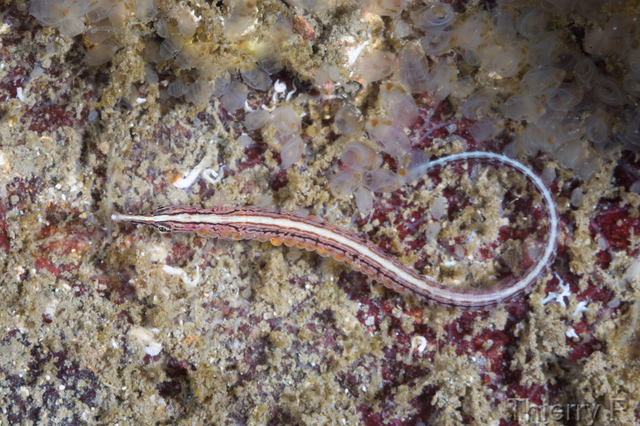Sawtooth Pipefish, Maroubra perserrata Whitley 1948

A Sawtooth Pipefish, Maroubra perserrata, at Shark Point, Sydney, New South Wales, 16 August 2016. Source: Thierry Rakotoarivelo / http://www.inbetweendives.com/. License: All rights reserved
A greyish to brown pipefish with a pale stripe along the head and back, a brown stripe on the side of the head, and often two narrow reddish-brown lines along the side. The common name refers to the spiny ridges on the body.
Sawtooth Pipefish, Maroubra perserrata Whitley 1948
More Info
|
Distribution |
Endemic to temperate southern Australian waters from southern Queensland to Rottnest Island, Western Australia. Inhabits coastal reefs at depths of 3-25m, sheltering beneath ledges and in caves during day. |
|
Features |
Dorsal fin 23-27; Anal fin 4; Pectoral fin 16-20; Caudal fin 10; Trunk rings 15-17; Tail rings 26-29; Total subdorsal rings 4.75-6.0. Body slender, elongate, trunk shallow; head aligned with body, snout moderately long and deep, 52-56% head length, snout depth 71-84% snout length. Posterior angles of body rings somewhat elevated and produced to spine-like points; superior trunk and tail ridges discontinuous near rear of dorsal-fin base; inferior trunk and tail ridges discontinuous; lateral trunk ridge confluent with lateral tail ridge and superior tail ridge; tail not prehensile; opercle with complete ridge angled upward towards gill opening, with prominent supplemental ridge radiating below. Dorsal fin closer to tip of tail than to head, base of moderate length; anal fin tiny, below front half of dorsal fin; caudal fin tiny; pectoral fin present. |
|
Size |
A small species, reaching 8.5cm SL. |
|
Colour |
Yellowish with irregular brown markings laterally on trunk and lower half of tail, sometimes with faint narrow dark stripe on side of trunk and upper surface next to superior ridge; broad dark stripe on side of snout; caudal fin usually pale above, brownish below. |
|
Feeding |
Sawtooth Pipefish are carnivores and feed on zooplankton and benthic crustaceans that are sucked in through the snout. |
|
Biology |
The sexes are separate and fertilization is external. Sawtooth Pipefish breed several times during the summer months within their first year of life. Like all syngnathids, males brood the eggs. Females deposit their eggs into a specialised region on the underside of the male's abdomen. The eggs develop in a sac-like brood pouch that lacks separate bilateral membranous folds. Males are likely to be brooding at 3.5cm TL. The eggs are relatively large, and fully grown males can brood about 60 eggs at a time. Larvae hatch after about 3 weeks and body rings are present at an early stage; the anal fin is reduced. |
|
Fisheries |
The species is sometimes collected for the aquarium industry. |
|
Conservation |
IUCN: Not evaluated. Australian Government Legislation: Marine listed under the Environment Protection and Biodiversity Conservation Act 1999 (EPBC Act). State Government Legislation: Listed as protected under New South Wales, Victorian, Tasmanian and South Australian Fisheries Management Acts. |
|
Remarks |
The Sawtooth Pipefish has been bred in captivity and is known to live for several years. In the wild individuals sometimes form small aggregations and often found together on rocky ledges. |
|
Similar Species |
The Sawtooth Pipefish is the only species in the genus Maroubra found in Australian waters. It is most similar to Maroubra yasudai from Japan, differing in colour pattern, fewer trunk rings (16-17 versus 22-23), fewer dorsal fin rays (23-27) and a deeper snout. |
|
Etymology |
The genus is named Maroubra after Maroubra Beach in Sydney, the type locality. Maroubra is an Australian vernacular name for the aboriginal route from Botany Bay to Port Jackson; marou = pathway and ora = place, country. The common name refers to the spiny ridges running along the body. |
|
Species Citation |
Maroubra perserrata Whitley, 1948. Rec. Aust. Mus. 22(1): 74, fig. 3, Maroubra Beach, near Sydney, NSW. |
|
Author |
Dianne J. Bray & Vanessa J. Thompson |
Sawtooth Pipefish, Maroubra perserrata Whitley 1948
References
Dawson, C.E. 1985. Indo-Pacific Pipefishes (Red Sea to the Americas). Gulf Coast Research Laboratory, Ocean Springs, Mississippi. 230 pp.
Dawson, C.E. 1994. Family Syngnathidae. pp. 440-474, figs. 391-426, In Gomon M.F., C.J.M. Glover & R.H. Kuiter (eds.) The fishes of Australia's south coast. State Print, Adelaide, 992 pp, 810 figs.
Hoese, D.F., D.J. Bray, J.R. Paxton & G.R. Allen. 2006. Fishes. In Beesley, P.L. & A. Wells (eds). Zoological catalogue of Australia. Volume 35. ABRS & CSIRO Publishing: Australia. 2178 pp.
Hutchins, J.B. 2001. Checklist of the fishes of Western Australia. Rec. West. Aust. Mus. Suppl. 63: 9-50.
Kuiter, R.H. 1993. Coastal Fishes of South-eastern Australia. Crawford House Press, Bathurst 437 pp.
Kuiter, R.H. 1997. Guide to sea fishes of Australia. A comprehensive reference for divers and fishermen. New Holland Publishers, Frenchs Forest, NSW, Australia, 434 pp.
Kuiter, R.H. 2000. Seahorses, Pipefishes and their Relatives. TMC Publishing, Chorleywood, UK. 240 pp.
Kuiter, R.H. 2009. Seahorses and their relatives. Aquatic Photographics, Seaford.
Paxton, J.R. 1975. Heraldia nocturna, a new genus and species of Pipefish (family Syngnathidae) from eastern Australia, with comments on Maroubra perserrata Whitley. Proc. Cal. Acad. Sci. 15: 439-447. http://www.biodiversitylibrary.org/item/53704#page/449/mode/1up
Pogonoski, J.J., D.A. Pollard & J.R. Paxton. 2002. Conservation Overview and Action Plan for Australian Threatened and Potentially Threatened Marine and Estuarine Fishes, Environment Australia, Canberra. 375 pp.
Whitley, G.P. 1948. Studies in ichthyology. No. 13. Rec. Aust. Mus. 22(1): 70-94.





